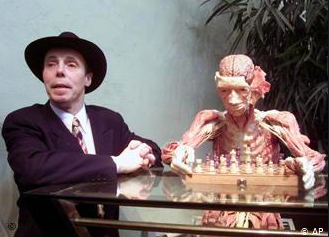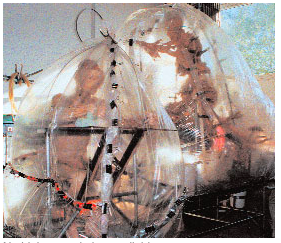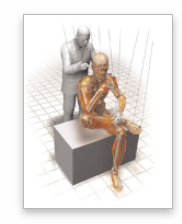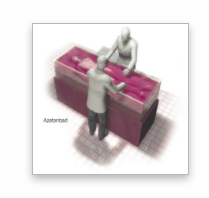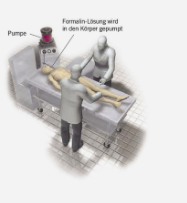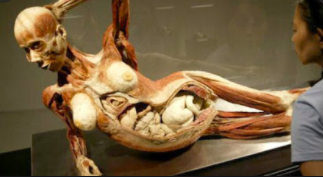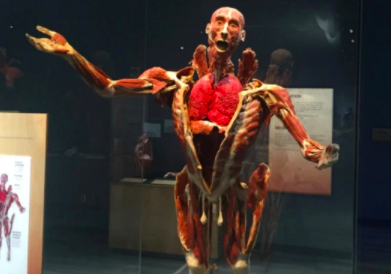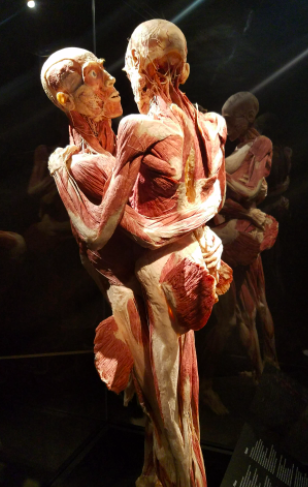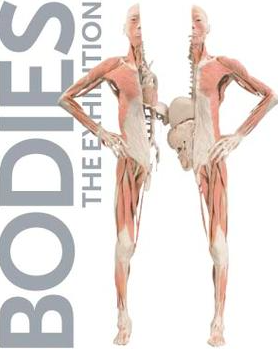THREAD: As promised, today I& #39;m going to be telling you about an exhibition that actually gave me nightmares. I learned about it while writing for an assignment relating to ethics, and I chose "human remains" as a topic. Boy oh boy the things I ended up coming across... https://twitter.com/ameni2many/status/1315717512034693120">https://twitter.com/ameni2man...
Our story starts with this man, Gunther Von Hagens, who was born in German-annexed Poland on the 10th of January 1945. He had a difficult childhood mainly because of soviet occupation, but also because he had a lot of medical issues.
So with all that time spent at hospitals, Von Hagens decided to study medicine in 1965 and received his doctorate in 1975. Then, two years later, he discovered something that would change his life, and the world, forever. He discovered plastination.
So what is plastination you ask? Plastination is a process used in anatomy to preserve bodies. The way it works is in four steps. First, there& #39;s fixation where the body is arranged in the pose or shape that the scientist wants them to keep, then, dehydration, where the...
(Ah I hate this so much I’m so squeamish), the body undergoes a process of fixation, which is for the body to be cleared of all bacteria and to prevent decomposition, followed by dissection. Then, the body is submerged with acetone in order to replace all the water and fat.
The acetone is then vaacumed out and replaced with plastic. The outcome of the process is 80% plastic and 20% organic material. While the product looks like genuine human tissue, the object looks and feels just like plastic.
Finally, the process ends with the body being positioned in a particular way and then finally hardened with heat, gaz, or light.
So this plastination process was a great success, to the point where he founded the Institute of Plastination in Heidelberg in 1993. He also ran a second plastination institute, this time in Dalian, China in 1996, and directed another plastination center in Kyrgyzstan
The purpose of this method was to preserve the body or bodyparts in the most realistic way possible in order to study the body. I mean imagine having anatomy lessons with actual human body parts you can study. I& #39;ve once seen a plastinated brain at a medical university. its crazy!
Anyway so plastination was only used for medical study for the first 20 years, mostly because you could only conserve smaller specimens. And then, once they learned how to plastinate whole bodied specimens in the early 90s, the game changed.
The first exhibition of fully plastified bodies was done in Japan in 1995. I guess it was a success because Von Hagens decided to develop the Body Worlds exhibition, which showcased these bodies in life like poses, some partially dissected to show systems of human anatomy
To produce the specimens, around 340 people work in five different labs in four different countries, which have different specialities. The china one does animal specimens for example (though I want you to remember china, china& #39;s an important aspect of our story later).
Because the objects were now turned into plastic, Von Hagens was able to create an exhibit without having to put effort on protection, allowing viewers to interact with it, and supposedly “banishing actual or symbolic barriers between the living and the dead”.
The aim of the exhibition, according to the mission and vision segment of the museum’s website, is for people to understand how the body works in order for them to choose healthy and sustainable lifestyles (encouraging them to eat better, quit smoking and drinking alcohol, ect..)
Today, both permanent and temporary exhibits are located in over 140 cities around the world, with 48 million people having seen it. It relies on the idea that by observing how lifestyle and diseases manifest in the body, it would encourage the visitors to make healthier choices.
So let’s get to the juicy question, WHERE DID THE BODIES COME FROM. According to the website, the bodies belonged to people who declared during their lifetime that their bodies should be made available after their deaths.
Within the Institute of Plastination in Heidelberg (which is actually led by Von Hagen’s Wife), there are about 18,833 registered body donors as of June 2019. It thus seems that there is a wide interest in the exhibit, but most importantly,
that it raised a significant amount of willingness to participation. The Body Wolrds exhibitions were so successful that other ones such as “Bodies: The Exhibition”, “The Amazing Human Body,” and “The Universe Within” were inspired to showcase real human plastified as well.
Here’s when the real nightmare starts.
One of the exhibitions that were inspired by Body Worlds is Bodies... The Exhibition, which is based in Atlanta and Las Vegas, and was visited by more than 15 million people). The exhibition holds over 200 human bodies “meticulously dissected and respectfully displayed”.
This exhibit has an interesting story. The bodies were plastinated by Dr Sui Jongjin, a once protege of Von Hangens, who after splitting from his mentor decided to partner with Premier Exhibitons and exhibit the same type of thing.
It holds extensive educational programs which have even received four educational awards and was even praised on the website by none other than Dr Mehmet Oz, Oprah’s medical correspondent who said that “Now America can taste Medical School” .
When I was exploring their website however, something was really really wrong. On the FAQ page, it is explained that the full body specimens come from China, because the “top dissectors and anatomy specialists live and work in China”.
They explained that these people “died from natural causes”, and because they were unclaimed bodies, following Chinese law, they were delivered to medical school for research and then plastinated.

 Read on Twitter
Read on Twitter